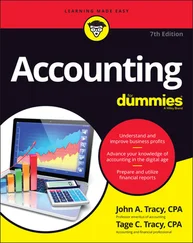Assets not directly required in the operating cycle, such as marketable securities held as temporary investments or short-term loans made to employees, are included in the current assets class if they will be converted into cash during the coming year. A business pays in advance for some costs of operations that will not be charged to expense until next period. These prepaid expenses are included in current assets, as you see in Exhibit 2.2.
The second group of assets is labeled “Long-Term Operating Assets” in the balance sheet. These assets are not held for sale to customers; rather, they are used in the operations of the business. Broadly speaking, these assets fall into two groups: tangible and intangible assets. Tangible assets have physical existence, such as machines and buildings. Intangible assets do not have physical existence, but they are legally protected rights (such as patents and trademarks), or they are such things as secret processes and well-known favorable reputations that give businesses important competitive advantages. Generally intangible assets are recorded only when the assets are purchased from a source outside the business.
The tangible assets of the business are reported in the “Property, Plant, and Equipment” account (see Exhibit 2.2again). More informally, these assets are called fixed assets , although this term is generally not used in balance sheets. The word fixed is a little strong; these assets are not really fixed or permanent, except for the land owned by a business. More accurately, these assets are the long-term operating resources used over several years—such as buildings, machinery, equipment, trucks, forklifts, furniture, computers, and telephones.
The cost of a fixed asset—with the exception of land—is gradually charged off to expense over its useful life. Each period of use thereby bears its share of the total cost of each fixed asset. This apportionment of the cost of fixed assets over their useful lives is called depreciation . The amount of depreciation for one year is reported as an expense in the income statement (see Exhibit 2.1). The cumulative amount that has been recorded as depreciation expense since the date of acquisition up to the balance sheet date is reported in the accumulated depreciation account in the balance sheet (see Exhibit 2.2). As you see, the balance in the accumulated depreciation account is deducted from the original cost of the fixed assets.
In the example, the business owns various intangible long-term operating assets. These assets report the cost of acquisition. The cost of an intangible asset remains on the books until the business determines that the asset has lost value or no longer has economic benefit. At that time the business writes down (or writes off) the original cost of the intangible asset and charges the amount to an expense, usually amortization expense . At one time the general practice was to allocate the cost of intangible assets over arbitrary time periods. However, many intangible assets have indefinite and indeterminable useful lives. The conventional wisdom now is that it’s better to wait until an intangible asset has lost value, at which time an expense is recorded.
You may see an account called “Other Assets” on a balance sheet, which is a catchall title for assets that don’t fit in the current assets or long-term operating assets classes. The company in Exhibit 2.2does not have any such other assets.
The accounts reported in the current liabilities class are short-term liabilities that, for the most part, depend on the conversion of current assets into cash for their payment. Also, debts (borrowed money) that will come due within one year from the balance sheet date are put in this group. In our example, there are four accounts in current liabilities. We explain these different types of current liabilities in later chapters.
Long-term liabilities, labeled “Long-Term Notes Payable” in Exhibit 2.2, are those whose maturity dates are more than one year after the balance sheet date. There’s only one such account in our example. Either in the balance sheet or in a footnote, the maturity dates, interest rates, and other relevant provisions of long-term liabilities are disclosed. To simplify, we do not include footnotes with our financial statements example in this chapter. (We discuss footnotes in Chapter 16.)
Liabilities are claims on the assets of a business. Cash or other assets that will be later converted into cash will be used to pay the liabilities. (Also, cash generated by future profit earned by the business will be available to pay the business’s liabilities.) Clearly, all liabilities of a business should be reported in its balance sheet to give a complete picture of the financial condition of a business.
Liabilities are also sources of assets. For example, cash increases when a business borrows money. Inventory increases when a business buys products on credit and incurs a liability that will be paid later. Also, typically a business has liabilities for unpaid expenses and has not yet used cash to pay these liabilities. Another reason for reporting liabilities in the balance sheet is to account for the sources of the company’s assets, to answer the question: Where did the company’s total assets come from?
Some part of the total assets of a business comes not from liabilities but from its owners investing capital in the business and from retaining some or all of the profit the business earns that is not distributed to its owners. In this example the business is organized legally as a corporation. Its stockholders’ equity accounts in the balance sheet reveal the sources of the company’s total assets in excess of its total liabilities. Notice in Exhibit 2.2the two stockholders’ (owners’) equity sources, which are called capital stock and retained earnings .
When owners (stockholders of a business corporation) invest capital in the business, the capital stock account is increased. Net income earned by a business less the amount distributed to owners increases the retained earnings account. The nature of retained earnings can be confusing; therefore, we explain this account in depth at the appropriate places in the book. Just a quick word of advice here: Retained earnings is not —we repeat, not —an asset. Get such a notion out of your head.
3 REPORTING CASH FLOWS
Statement of Cash Flows
Chapter 2introduces the two hardcore financial statements that are included in the financial report of a business, the income statement ( Exhibit 2.1) and the balance sheet ( Exhibit 2.2). Both of these provide a comprehensive summary of the financial performance and financial condition of the business; however, this is not the end of the story. Financial reporting standards require that a statement of cash flows also be presented for the same time period as the income statement.
This third financial statement, as its title implies, focuses on the cash flows of the period. The cash flow statement is not more important than the income statement and balance sheet. Rather, it discloses additional information that supplements the income statement and balance sheet.
Exhibit 3.1presents the statement of cash flows for our business example. This financial statement has three parts, or layers : 1) cash flows from operating activities, 2) cash flows from investing activities, and 3) cash flows from financing activities. Operating activities relate to the profit-making activities of the business. Of course, a business may suffer a loss instead of making profit. On a statement of cash flows, the term “operating activities” refers to revenue and expenses (as well as gains and losses) during the period that culminate in the bottom-line net income or loss for the period.
Читать дальше












